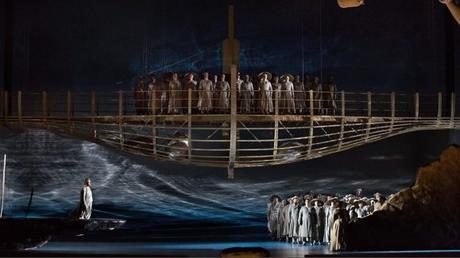 Rossini’s Guillaume Tell at the Metropolitan Opera (Photo: Marty Sohl / Met Opera)
Rossini’s Guillaume Tell at the Metropolitan Opera (Photo: Marty Sohl / Met Opera)Past Glories, Future Successes
There’s no doubt about it: the Metropolitan Opera House is in trouble. Financially and artistically, in every conceivable way an opera company can expect to have difficulties. Hard times are indeed ahead for the performing arts in general. Yet, there is always something to rave about.
While the past 2016-2017 Met broadcast season wasn’t the most audacious or artistically absorbing I’ve heard or read about, it did have some outstanding features. In my book, the main attraction — one we opera fans have long been waiting for — was the new Pierre Audi production of Rossini’s Guillaume Tell (“William Tell”), one of those celebrated creations one reads about only in history books but rarely gets the opportunity to actually experience.
About all that modern audiences know of the piece is that it was Rossini’s last completed opera. The Met Opera management is to be commended, then, for bringing the Dutch National Opera’s 2013 production to New York, the first such performance of the work at the company in nearly eighty-five years.
Based on the legend of the Swiss folk hero who united the Swiss against a ruthless Austrian ruler, Guillaume Tell had a rousing reception at its premiere at the Paris Opéra on August 3, 1829. Rossini biographer and radio broadcaster Richard Osborne, writing in Opera on Record 3, commented that the opera indisputably pointed “the way forward to the later nineteenth-century Italian and French traditions. Though a composer like [Giacomo] Meyerbeer was content merely to seize the ground plan…, it is arguable that Tell equally well paved the way for the great political dramas of the Verdi years – Nabucco, Don Carlos, and Simon Boccanegra – as well as Verdi’s own great drama of paternity, Rigoletto.”
Osborne goes on to state: “What Rossini’s shrewder heirs inherited from Guillaume Tell was a new musical plasticity and power; a reorientation and humanization of the near-defunct baroque and neo-classical styles. Inspired by [Friedrich von] Schiller’s magnificent play [as, indeed, Verdi himself was inspired by the same author’s The Maid of Orleans, The Robbers, Love and Intrigue, and Don Carlos], Rossini takes heroic opera out of the fabled world of high romance and brings it into the mainstream of contemporary thought and feeling.”
After decades of slaving away in the galleys, as many Italian composers of the period were expected to do, an exhausted but exceedingly well-off thirty-seven-year-old Gioachino Rossini laid down his pen and vowed never to write another stage work. Rossini kept to that promise, although he continued to compose a variety of parlor pieces and sacred music, among them the lovely Stabat Mater and the song cycle “Sins of My Old Age.”
The Macro and Micro View
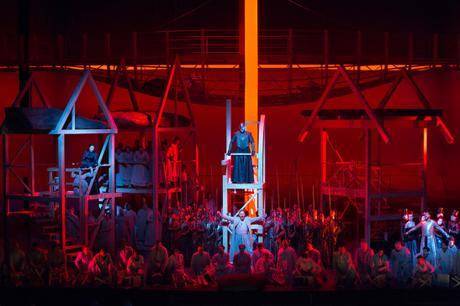
So what is Guillaume Tell really like? Why has this infrequently performed work had such an elevated status among knowledgeable music buffs and critics? To begin with, it’s an unwieldy opus. Four acts, a four-and-a-half-hour running time (according to the Met Opera’s broadcast statistics), an unimaginably torturous lead role for tenor, an expanded chorus, elaborate ballet sequences, and other extra-scenic requirements (including Tell’s last-minute rescue attempt across Switzerland’s Lake Lucerne) have made it a tough slog for an evening’s entertainment.
Aw, heck, you say. That doesn’t sound like much! Why, the mighty Ring cycle itself has been testing the theatrical capabilities of opera houses for decades. And as far as elaborate tenor roles go, some may share the belief (as I most certainly do) that Wagner’s Tristan and Siegfried are still two of the most grueling operatic assignments of this or any other time. There’s got to be more to it than that!
And indeed there is. Despite its monumentality, Rossini’s French-language extravaganza is a truly melodious piece, one of the composer’s finest and most thoughtfully-conceived stage products. Done with craft and artful intelligence, Guillaume Tell is unlike anything the native from Pesaro had turned out before. In the revealing article, “Rossini’s Last Stand,” by New York Times critic Peter G. Davis for the October 2016 edition of Opera News, the work is heralded for its “romantic, even heroic grandeur,” with the “master’s inimitable touch” present “on nearly every page.” Davis praised the “new expressive freedom and individuality” that “courses through the entire opera.”
The world-famous overture, with its thrice-familiar Lone Ranger theme and other recognizable tunes (used liberally in a wide variety of TV programs, movies, cartoons, and advertisements), “sets the tone … in essence, a boldly conceived, four-part symphonic poem [reflecting, if you will, the four-part partition of the opera itself] conjuring up the Alpine panoramas in which this stirring patriotic drama takes place.”
The opera’s qualities are apparent from the start. As indicated in the above passage, the instrumental writing in the overture alone is absolutely breathtaking. Rossini’s descriptive use of the cellos, followed swiftly by the thunderous storm music, which gives way to the simplicity and beauty of the dawn music with cor anglais and accompanying flute obbligato, as well as the triumphant stretto section in the brass — all are symptomatic of a first-class musician at the peak of red-hot inspiration.

Still, the question remains: How does one approach an opera of this magnitude if not from the standpoint of admiration and respect? On the one hand, this was a French grand opera, in spite of its having been written by one of Italy’s finest proponents of bel canto. On the other, it is also an endurance test of phenomenal proportions. In short, this is one of those astonishingly conceived oeuvres for which the term “legendary” has more than sufficient merit.
The opening pastoral and the fisherman Ruodi’s gentle love song — with its unforeseen yet excitingly rendered high C (from a minor character, at that) — indeed, every turn of phrase is of major significance to the drama’s development, a novelty in grand opera at the time. We sense this aspect not only in the title part (actually, second only to that of the tenor Arnold), but in the soprano Mathilde’s reflective Act II air, the cavatina “Sombre forêt” (“Selva opaca,” or “Somber forest”) with its gentle drum roll interspersed throughout.
As you can tell (no pun intended), casting is paramount in a work such as this, and the Met spared no expense in that department. The broadcast of March 18, 2017 (from the October 18, 2016 premiere) starred Canadian baritone Gerald Finley as Tell, New Orleans-born tenor Bryan Hymel as Arnold, and Latvian soprano Marina Rebeka as Mathilde, with debuting tenor Michele Angelini as Ruodi, soprano Janai Brugger as Jemmy, mezzo-soprano Maria Zifchak as Hedwige, bass Kwangchul Youn as Melcthal, bass Marco Spotti as Walter Furst, and bass-baritone John Relyea as Gessler.
Italian maestro Fabio Luisi conducted the Met Opera Orchestra and Chorus — vibrantly, I am happy to report. The sets were designed by George Tsypin, the costumes by Andrea Schmidt-Futterer, with lighting by Jean Kalman, and choreography by Kim Brandstrup. Donald Palumbo, as always, was the chorus master.
Step Up to the Plate
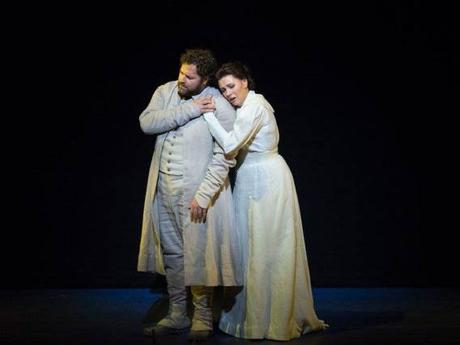
For all the worthwhile efforts he brought to bear on this marvelous score, Rossini left it to posterity as to how the part of Arnold (or “Arnaud” in the original French) should be handled. THAT, dear readers, is the real issue at hand.
Who in the past was capable of encompassing the extreme range of Arnold’s music? I won’t resurrect the age-old argument as to whether the many Gs, As, Bs, Cs, and Ds should be taken at full-voice (“high C from the chest,” i.e. do di petto, in Italian) or done in voix mixte (“mixed voice”) mode. Whatever it takes to get those “money notes” out, when done right, will bring the public to its feet come curtain time.
Past recorded exponents were wont to negotiate the role’s difficulties in various and sundry forms. Singers from the dawn of recording, the so-called gramophone era, managed to work their way around the hurdles, while others were not as successful. Readers can come to their own conclusions as to which method was best, usually from a personal perspective.
Fortunately, there are lots of examples to choose from, mainly from the Golden Age by such splendid artists as Francesco Tamagno, Giovanni Martinelli, Giacomo Lauri-Volpi, Francesco Merli, Mario Filippeschi, Georges Thill, René Verdière, César Vezzani, Hermann Jadlowker, Léon Escalais, and others. Among modern singers, one may thrill to the voices of Luciano Pavarotti, Nicolai Gedda, Alfredo Kraus, Chris Merritt, Michael Spyres, John Osborn, and Juan Diego Flórez.
What about the title role of Tell? Good question. On the Italian front, baritones as far afield as Giuseppe de Luca, Giuseppe Danise, Gino Bechi, Benvenuto Franci, Tito Gobbi, and Giuseppe Taddei have left some wonderful recorded mementos of the soulful aria “Sois immobile” (“Keep still”), or “Resta immobile” in Italian translation. From the Gallic side, we have the impeccably tasteful Jean Borthayre (a baryton martin that I much admire, whose superb diction was above reproach), Maurice Renaud, Arthur Endrèze, Ernest Blanc, and Gabriel Bacquier.
Some more Golden Age extracts include the first act duet between Tell and Arnold (“Ah, Mathilde, je t’aime”) with the tenor’s powerful high notes, sung to near perfection by the likes of Taddei and Filippeschi on the Cetra label; with Bechi and Filippeschi again in a private recording; Franci and Toscanini’s favorite tenor, Aureliano Pertile; Leo Slezak and Leopold Demuth; and the remarkable Martinelli (talk about robust!) with Marcel Journet. There’s also the great third act trio for Tell, Arnold and Walter Furst, delivered in waves of passionate intensity by Martinelli, with De Luca and Spanish basso José Mardones setting the standard for how this piece should be sung.
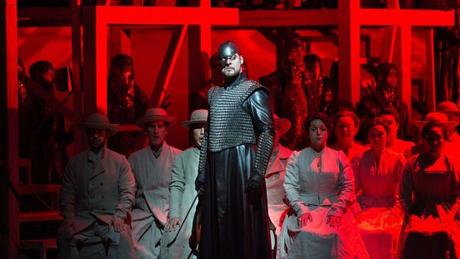
While not a dramatic tenor by nature or birth, Bryan Hymel’s gloriously translucent tone overcame most of Arnold’s vocal hurdles. Despite some treacherous footing in the staging itself, this was a most fortuitous assumption for the artist. Although he struggled valiantly in reaching for those stratospheric Cs during his long Act IV scena, Hymel delivered the prayerful “Asile héréditaire” (“O muto asil del pianto”) with pointed tone and meltingly luxuriant voice; this was followed by the furious cabaletta with chorus, “Amis, amis!” (“Corriam, voliam!”), a rafter-raising precursor to Manrico’s “Di quella pira” from Verdi’s Il Trovatore.
Having conquered Carthage in Berlioz’s Les Troyens, Hymel prepared to rescue Tell in this riveting sequence. Recalling the late, great Luciano Pavarotti’s ringing 1971 London/Decca recording of the aria and cabaletta (severely truncated, if I recollect correctly), I can only state that Hymel has placed himself in good company. Few artists can muster the rock-solid singing technique and punch to the solar plexus this episode demands. Subtlety and finesse are also called for, as well as stamina and endurance. Lung power alone won’t get you through this obstacle course, as many opera buffs can confirm. Heard in its entirety, the scene can be a riveting theatrical experience. It takes guts to make this role a success, or so one would think.
That’s not how Rossini heard it. In his day, Arnold’s music was in the respectable hands of Adolphe Nourrit, the epitome of taste and bel canto refinement. Just a few years hence, a robust rival named Gilbert-Louis Duprez (who created the role of Edgardo in Donizetti’s Lucia di Lammermoor) tried a more novel, muscular approach with his high C from the chest. When he heard Duprez’s version, Rossini famously compared it to a chicken getting its throat cut. Gulp! Incidentally, Duprez was indirectly responsible for Nourrit ending his career in suicide.
As for the rest of the cast, the highly underrated Gerald Finley was a model Tell. His fine-grained, burnished baritone, perfectly even from top to bottom and filled with a lush, buzzy timbre, was an absolute joy to listen to. No wonder he’s made such a hit with Wagner’s Hans Sachs in Die Meistersinger: this is masterful singing by an artist of the first rank. A definitive interpretation and one for the record books.
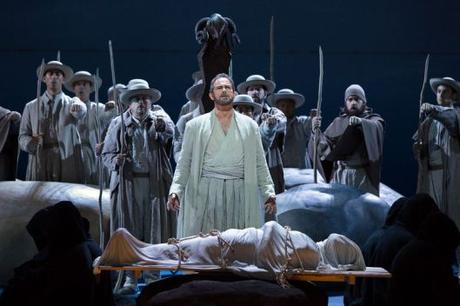
Riga-born soprano Marina Rebeka as Mathilde, while gamely tackling the many beauties this part has to offer, did not combine especially well vocally with Hymel, her romantic tenor lead. Nevertheless, she lent needed pathos as well as softness to her singing. Not intimidated in the least by the assignment, Rebeka had some solid recorded competition in Frances Alda, Claudia Muzio, Lina Pagliughi, Renata Tebaldi, Maria Callas, Rosana Carteri, Montserrat Caballé, Mirella Freni, and Cheryl Studer.
The other singers acquitted themselves well, especially the appealing Jemmy of Janai Brugger. However, a special shout-out is called for to Toronto-born artist John Relyea as the villainous Governor Gessler, a stupendously realized conception. His snarling, sturdy bass-baritone and malevolent characterization of this evil antagonist were convincingly conveyed over the air with firmness and relish. Relyea came off best of all as a scoundrel, your proverbial baddie.
Back in the late-1980s, I remember seeing the young Relyea as Méphistophélès in the Frank Corsaro production of Gounod’s Faust at New York City Opera. The Faust on that occasion was the equally talented Richard Leech, another rising star on the operatic firmament. Much later, I bought a Telarc digital LP of the Prologue to Boito’s Mefistofele, with Relyea singing the “Ave Signor!” in that wonderfully potent voice of his. He also made a magnificently commanding devil in Berlioz’s fantastical The Damnation of Faust in Robert Lepage’s stylized high-tech production at the Met from 2008.
It was great to have Relyea back in such superbly diabolical form. The next time they present Offenbach’s The Tales of Hoffmann can the Met Opera management please engage him as the Four Villains? PRETTY PLEASE? It was an even more satisfying experience to have finally heard Guillaume Tell at the Met. May they both return with renewed vigor.
(End of Part One… To be continued)
Copyright © 2017 by Josmar F. Lopes
Advertisements
